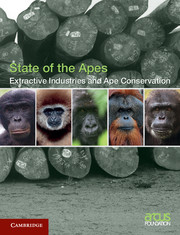Book contents
- Frontmatter
- Foreword
- Contents
- The Arcus Foundation
- Notes to readers
- Acknowledgments
- Photo
- Introduction
- Section 1
- 1 From global to local: the megatrends at the interface of apes and industry and the case of trade, law, and finance
- 2 Land tenure: industry, ape conservation, and communities
- 3 Ecological impacts of extractive industries on ape populations
- 4 Avoiding the chainsaws: industrial timber extraction and apes
- 5 Mining/oil extraction and ape populations and habitats
- 6 Artisanal and small-scale mining and apes
- 7 The bigger picture: indirect impacts of extractive industries on apes and ape habitat
- 8 Case studies of national responses to the impacts of extractive industries on great apes
- Section 2
- Annexes
- Acronyms and abbreviations
- Glossary
- References
- Index
4 - Avoiding the chainsaws: industrial timber extraction and apes
Published online by Cambridge University Press: 05 June 2014
- Frontmatter
- Foreword
- Contents
- The Arcus Foundation
- Notes to readers
- Acknowledgments
- Photo
- Introduction
- Section 1
- 1 From global to local: the megatrends at the interface of apes and industry and the case of trade, law, and finance
- 2 Land tenure: industry, ape conservation, and communities
- 3 Ecological impacts of extractive industries on ape populations
- 4 Avoiding the chainsaws: industrial timber extraction and apes
- 5 Mining/oil extraction and ape populations and habitats
- 6 Artisanal and small-scale mining and apes
- 7 The bigger picture: indirect impacts of extractive industries on apes and ape habitat
- 8 Case studies of national responses to the impacts of extractive industries on great apes
- Section 2
- Annexes
- Acronyms and abbreviations
- Glossary
- References
- Index
Summary
Introduction
Industrial timber extraction is dominated by the removal of timber for round wood. It is considered a serious threat to biodiversity with significant repercussions, particularly for forest-dependent species such as the great apes and gibbons, who rely on the forest and its resources for survival. Most of the tropical forest zone is covered with logging concessions and will likely be logged unless there is a change in land-use allocation. As different types of logging have emerged, so too have their impacts on the environment. In particular, selective logging, although extensive in nature, has relatively less impact. However, if the long-term impacts on the fate of the great apes and gibbons of old-growth habitat transformation to secondary forests and further degradation by repeated logging are to be significantly reduced, harvesting intensity must remain low and over longer time frames.
Current knowledge on the effects of logging on gibbons is outlined in Chapter 3; however, because of the lack of information on conservation efforts with gibbon species in logging concessions, this chapter focuses on the interface of logging with great apes only.
The initial section of this chapter presents detail on the various forms of industrial logging with particular emphasis on sustainable management and its uptake and impact on the environment. Section two focuses more specifically on the interface of great apes and industrial logging.
- Type
- Chapter
- Information
- Extractive Industries and Ape Conservation , pp. 100 - 125Publisher: Cambridge University PressPrint publication year: 2014



